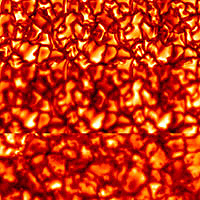






 |
 |

Solar Granulation
Caption:
Solar granulation as seen in radiation emerging from the surface. The top panel is a mosaic of three snapshots taken from a simulation at one-minute intervals. The middle panel is the simulation mosaic filtered with the point-spread function of the telescope and Earthís atmosphere. The bottom panel is an actual observation from a Swedish solar telescope. [mage 2 of 4 related images; see also, Entropy Fluctuations, Vorticity and Turbulence, and Solar Convection and Entropy.]
More about this Image
Robert Stein, a physics and astronomy professor at Michigan State University, and Aake Nordlund of Copenhagen University Observatory in Denmark, used the National Computational Science Allianceís SGI Origin2000 supercomputer, located at the National Center for Supercomputing Applications (NCSA), to create massive models of portions of the sun to simulate the processes behind the sunís smaller-scale features. Using these models, the team focused on understanding convection and magnetic flux near the solar surface. Stein and Nordlund have used supercomputers to study the nature of the sun for more than 15 years.
Rather than create the simulation through a variety of modeling applications, the team uses a single, integrated code. Their code is based on the laws of conservation of mass, momentum, and energy as well as the forces of pressure, gravity, and the magnetic field. Solving the equations that represent these laws and forces allows the researchers to see the essential physics at work, the radiative cooling at the surface that drives convection and the turbulent motions that generate small-scale magnetic fields and shuffle them around, for example.
On four to six Origin2000 processors, it takes about one day to simulate 30 seconds of time on the sun. Eventually, they hope to simulate about one day on the Sun.
Using the teamís newest simulations, they hope to learn how much small-scale magnetic flux is generated by convection, how larger-scale structures are related to granulation, and how to calibrate sound waves to observe phenomena near the solar surface.
This work was supported by the National Science Foundation (grants AST 95-21785 and AST 98-19799), NASA, and the Danish Research Council.

(Preview Only)

|
| Credit: |
Robert Stein, Phys. and Ast. Dept., Michigan State Univ.; and Aake Nordlund, Astronomy Observatory, Copenhagen Univ., Denmark. Calculations performed at the Nat. Cent. for Supercomputing Apps., Michigan State Univ., and the Univ. of Denmark. |
| Decade of Image: |
2000 - 2009 |
|
Categories:
ASTRONOMY / Solar
Formats Available:
Restrictions:
Under no circumstance can this image be used without proper credit, as stated in the credit line.
|